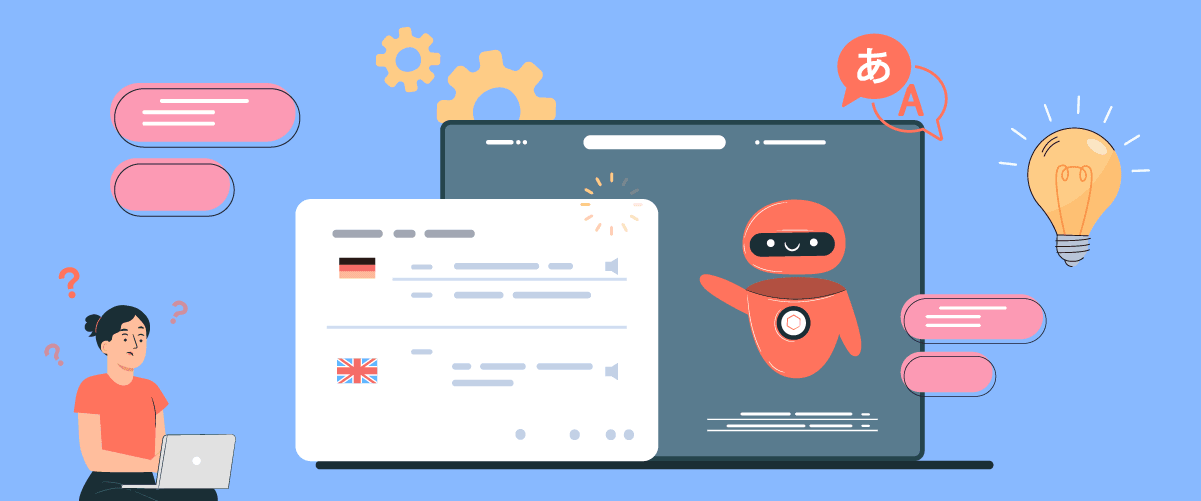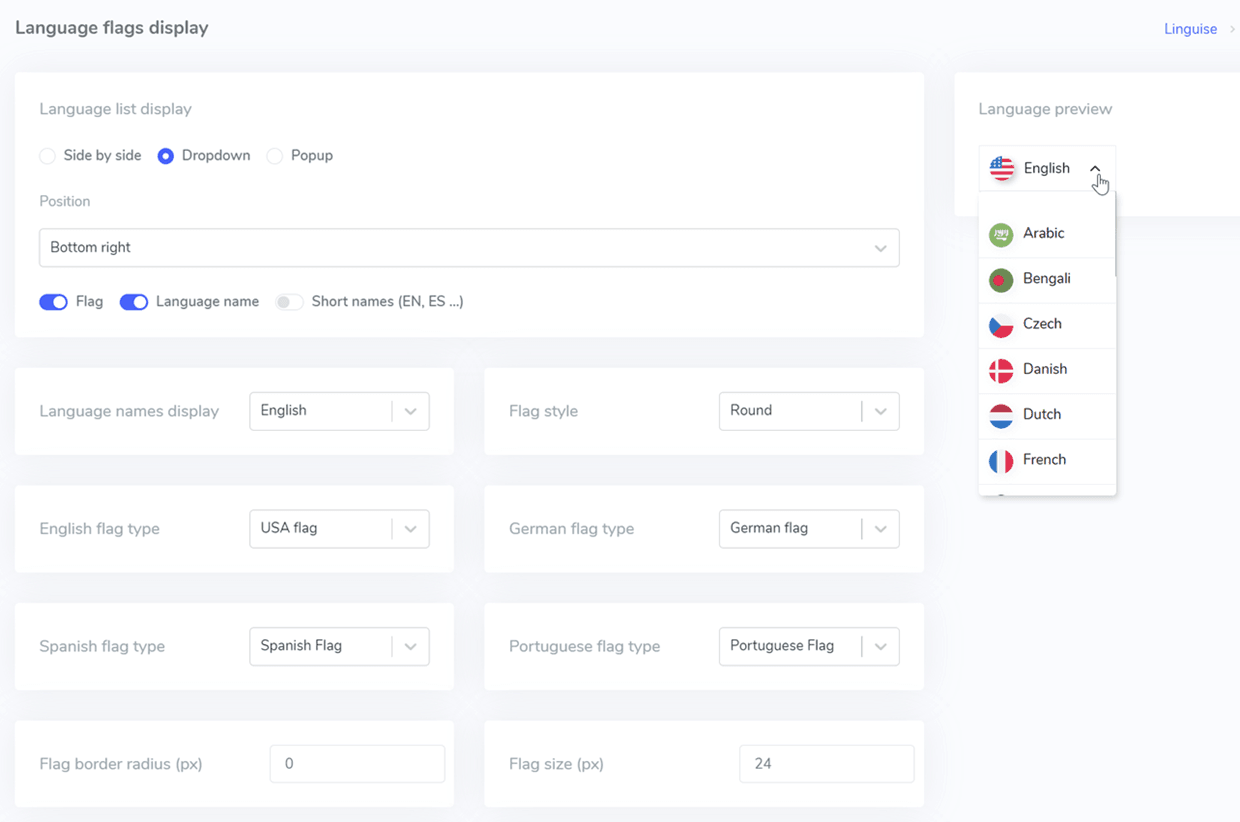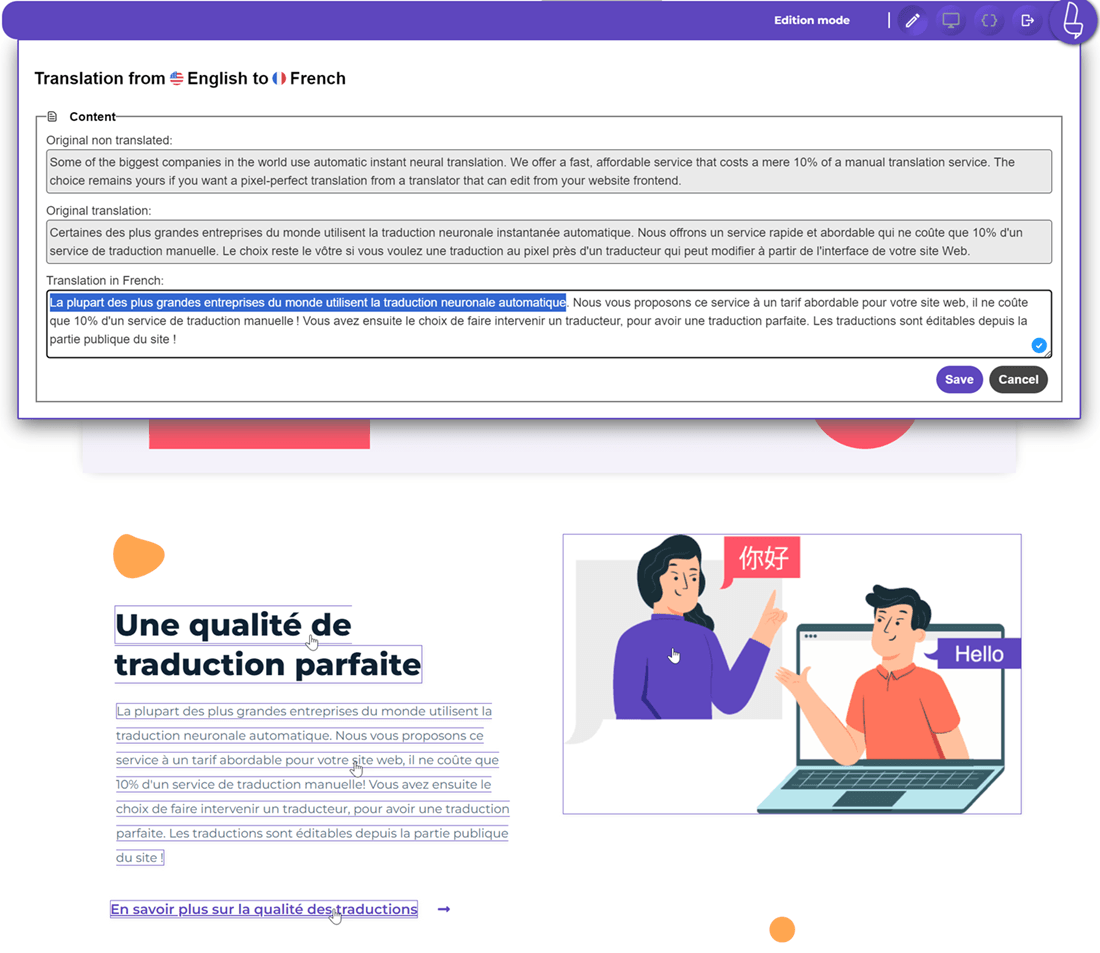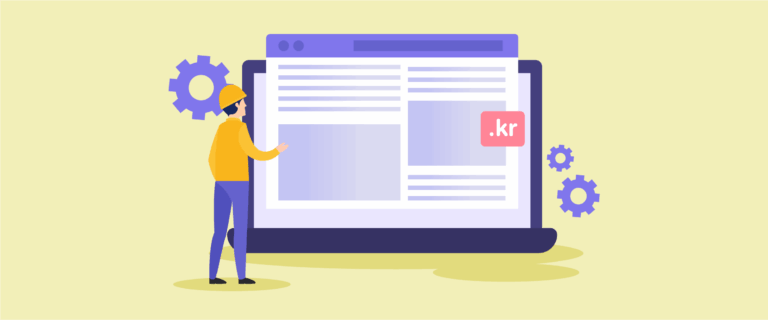Translating website content can often pose a challenge for businesses aiming to achieve a multilingual website. However, manually translating content can be time-consuming therefore, you can consider using alternatives such as AI translation.
AI translation is a technology that automatically translates text from one language to another. This technology has advanced rapidly in recent years, becoming increasingly accurate and capable of capturing nuances from various languages.
By leveraging AI translation, businesses can streamline the process of translating their website content, reducing the time and resources required for manual translation.
In this article, we will comprehensively discuss what AI translation is, its development over time, and the benefits of using AI translation.
What is AI translation?
AI Translation is an automatic translation process based on machine learning algorithms. These algorithms can understand the original text, translate it, and generate text in the target language.
Machine learning algorithms utilize neural network technology inspired by the workings of the human brain to produce translations that closely resemble human translations. This technology is combined with neural language processing to comprehend word meanings and structure sentences with human-like grammar and context-appropriate language.
AI translation-based applications will translate content from one language to another automatically, without any human intervention. For example, from English to Spanish and vice versa.
In the past, AI translation started with translations that tended to be less accurate, less natural, and often did not match the context of the reading material. However, advancements in AI have significantly improved the quality of AI translations, resulting in translations with high accuracy and more natural language.
So, currently, AI translation is an effective tool for translating content, including website content, especially in the process of creating multilingual websites.
The evolution of AI translation over time
Before becoming what it is today, with accurate translations, context-sensitive, and culturally nuanced, this translation has developed over time. Here is the evolution of AI translation from era to era.
1970 - RBMT (Rule-Based Machine Translation)
Rule-based machine translation is the initial machine translation model that relies on linguistic rules, grammar, and dictionaries to translate text from one language to another. RBMT combines language, grammar rules, and dictionaries to translate common words. To ensure that the terminology remains relevant and consistent in each industry, specialized dictionaries focus on specific industries or disciplines.
1990 - SMT (Statistical Machine Translation)
This technology employs a statistical and probabilistic approach. It starts by gathering a large amount of text data and translating it into two languages. Then, the Statistical Machine Translation (SMT) system learns from this data. After learning the language patterns within the collected text and translations,
the SMT system will employ the trained model when receiving text for translation. Hence, to automatically learn translation patterns, SMT utilizes statistics and probabilities from a vast amount of text and translation data.
2013 - NMT (Neural Machine Translation)
In 2013, Neural Machine Translation (NMT) was introduced, marking significant progress in machine language translation. The new method, NMT, allows machines to learn translation through highly expansive neural networks. These neural networks are modeled with various processing units based on the human brain.
The training method of NMT utilizes large parallel data sets, enabling them to learn patterns and relationships between languages at a higher level of sophistication than previous methods.
This approach enables machines to learn translation without relying on language rules or dictionaries, thus tackling more complex linguistic challenges and producing more accurate and relevant translations. They can also better capture context and nuances, handle long-distance dependencies more effectively, and generate more natural and fluent translations.
The technology that AI translation uses now
After understanding the evolution of translation technology over time, what technology is predominantly used for translation today?
Before delving further, there are 3 methods of machine translation that we have discussed:
- Neural Machine Translation (NMT)
- Rule-based Machine Translation (RBMT)
- Statistical Machine Translation (SMT)
Most AI translation software today utilizes NMT or combines two or more machine translation methods to produce accurate results.
Some machine translation providers that utilize neural technology and AI translation include Google Translate, DeepL, Amazon Translate, and Microsoft Translator.
Currently, neural machine translation is the most advanced technology in the translation industry that can be used to translate content, including in creating multilingual websites.
Advantages and disadvantages of AI translation in website translation
Even though AI translation is the most modern technology today, it still has advantages and disadvantages regarding website translation. The following are some of them.
Advantages of AI translation
- Fast and efficient: AI translation can be done instantly and handle large volumes of content in real time. For example, if an e-commerce website wants to translate thousands of product pages into various languages, AI translation would be much faster than assigning a human translation team.
- Consistent: AI translation provides consistent translation quality for all sentences. For instance, if you translate a phrase on one page, then the same phrase appears on another page, the translation result for that phrase will be the same.
- Can be further developed to suit industry needs: AI translation platforms can be enhanced by teaching them to use specific terms consistently. For example, an AI translation platform in the medical industry can be taught to use specialized and accurate medical terms according to industry standards.
- Easy to use: AI translation tools like Google Translate are very user-friendly; you just need to copy and paste, and the translation result will appear. Or using platforms integrated with AI translation tools. For example, a website provides an automatic translation button that allows users to switch the site’s content to the desired language easily.
- Provides many languages: AI can translate into multiple languages at once. However, remember to add languages according to the target audience and countries. You can gradually add them rather than adding too many at once.
- Integrated with the website: Some AI automatic translation services are generally integrated into web pages to facilitate users switching from one language to another using a language switcher.
- Affordable cost: Compared to the cost of human translation, the cost of AI translation is more affordable. For example, the monthly subscription cost for using an AI translation platform is usually lower than the cost of hiring a human translation team.
Disadvantages of AI translation
- Limited ability to capture cultural nuances: AI still cannot accurately translate nuances, idioms, and cultural specifications. For example, certain phrases or expressions in a particular language may have deep cultural meanings that are difficult for AI translation algorithms to grasp.
- Limited in translating emotions: It’s important to remember that AI is not a human with emotions. AI translation cannot fully translate all the emotions present in a text. For instance, in translating poetry or advertisements that focus on emotional language, AI may struggle to capture and maintain the original emotional tone.
- Limited context: AI often struggles to understand broader contexts and implied text meanings. For example, in translating literary works or highly contextual technical texts, AI may have difficulty interpreting the meanings of words or phrases without adequate context.
- Requires human post-editing: Although capable of translating quickly and accurately, machine translation results still need to undergo further editing by humans to ensure optimal quality and accuracy.
Benefits of AI translation for your business
When applied, AI translation certainly provides many benefits, especially for businesses utilizing it for website translation. Here are some key advantages of using AI for translation for your company.
Expanding market reach: AI translation enables companies to translate website content, such as product descriptions or services, into various languages quickly and efficiently. This helps reach customers in different countries. Research indicates that 76% of customers prefer to buy goods in their language, while 40% will not purchase from websites available in other languages. For example, e-commerce businesses can translate thousands of product pages into 7 languages in a short time using AI translation, thereby opening access to new markets worldwide. Businesses can enter the global market and reach new customers.
Enhancing online visibility: Translating content into various languages can increase the presence of that content in the target languages. Customers will search for information in their respective languages. If your site is translated into various target languages using AI translation, such as Japanese, Arabic, Russian, and others, your site has the potential to appear in search engine results for users in those countries. This is because search engines rely on keywords and content in specific languages to determine the relevance of a web page to search queries. For example, a tourism website that translates its content into Mandarin and Japanese will be easier for tourists from those countries to find when searching for vacation information.
Improving customer experience: Businesses using AI translation can serve multilingual markets more effectively and provide better customer service to international customers. For example, if product descriptions and customer support are presented in the user’s native language, they will feel more comfortable and confident when making transactions. This encourages customers to make repeat transactions in the future. For example, a software company that provides technical documentation in the user’s local language for their products ensures that instructions are easy to understand, preventing customer confusion and demonstrating care for their global user base.
Cost efficiency: The cost of AI translation is generally lower than human translators, especially for large volumes of content and translations into multiple languages. Cost savings help businesses allocate budgets to other areas. For example, an online store business that needs to translate hundreds of products into 10 languages can save thousands of dollars by using AI translation instead of hiring human translators for each language. AI translation allows businesses to translate more content at a lower cost.
How does Linguise utilize AI technology for translation?
AI translation can be used to translate various content, including website content. In translating websites into multiple languages, various automatic translation services can translate web content, one of which is Linguise.
Linguise is one of the translation services that utilizes this approach to provide high accuracy in translating website content.
At Linguise, we use the best Neural Machine Translation (NMT) model from Google to ensure you get the most accurate translation for your website content. This NMT model is continually updated, guaranteeing improved translation accuracy to their clients, which is available in various languages. By leveraging the latest cloud AI technology, Linguise can produce high-quality translations that capture nuances and context accurately.
Moreover, Linguise also comes with several outstanding features that support translation.
- High translation quality up to 97%, comparable to human translation.
| NMT Translation | Human Translation | Quality | |
| English-Spanish | 5,428 | 5,550 | 97% |
| English-French | 5,295 | 5,496 | 96% |
| English-Chinese | 4,594 | 4,987 | 92% |
| Spanish-English | 5,187 | 5,372 | 96% |
| French-English | 5,343 | 5,404 | 98% |
| Chinese-English | 4,263 | 4,636 | 92% |
- 100% multilingual SEO-friendly, supporting SEO-friendly translation techniques, so search engines can automatically index your translated content well. Such as implementing hreflang tags, translating URL slugs, using canonical URLs, etc.
- Integrated with over 40+ website platforms and CMS, you can translate your website content smoothly without leaving your workspace.
- Linguise supports over 85 language options, including both international and less common traditional languages.
- Unlimited language addition, you can add as many languages as needed to your website.
- Provides language switcher customization feature. You can set the design language selector according to your needs, starting from set, icon shape, color, size, etc.
- Front-end live editor feature that allows users to edit machine translation results. You only need to select the part you want to edit the translation for, then enter the translation that you think is accurate. This can be done easily via the Linguise dashboard.
- Allows adding professional translators to the Linguise dashboard to assist in manual translation editing.
- Translation rules feature to exclude translations based on criteria such as text ignore, text replacement, exclusion by URL, etc.
Conclusion
AI Translation is a technology that utilizes sophisticated machine learning algorithms to understand source texts and produce accurate translations into other languages. The evolution of AI Translation began with rule-based approaches (RBMT), then progressed to statistical approaches (SMT), and finally reached its peak with Neural Machine Translation (NMT).
Currently, most AI translation services utilize NMT or a combination of several methods. For businesses, AI Translation can provide significant benefits such as expanding global market reach, increasing user engagement, and more.
Linguise is one of the translation services that harnesses AI Translation and NMT to generate high-quality translations for website content. Linguise comes with outstanding features such as a front-end live editor, integration with popular website platforms, diverse language options, and the ability to customize translations.
For those in need of website translation services, Linguise can be the right solution. So, what are you waiting for? Register for a Linguise account now, try on free trial for 30 days and sign up your website to create a multilingual website to reach global markets!







